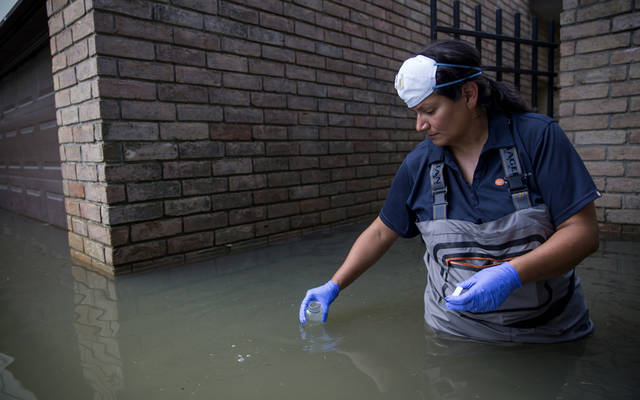‘Flesh-eating bacteria’ causes second death in Texas since Harvey

NEW YORK TIMES
A researcher collects samples from floodwaters in a neighborhood of Houston on Sept. 5 following Hurricane Harvey. A 31-year-old man who helped repair houses in Galveston after Hurricane Harvey has died of a rare infection caused by what is commonly known as flesh-eating bacteria, health officials said. It was the second reported death of a person from the infection since the storm swept through parts of Texas in August.
A 31-year-old man who helped repair houses in Galveston, Texas, after Hurricane Harvey has died of a rare infection caused by what is commonly known as flesh-eating bacteria, health officials said this week.
The man went to the hospital Oct. 10 with a seriously infected wound on his upper left arm, the Galveston County Health District said in a statement Monday. He was told he had necrotizing fasciitis, a bacterial infection that kills soft tissue. He died Oct. 16.
Relatives who spoke to local news organizations identified the man as Josue Zurita. “He’s a very caring person,” Brenda Avalos, his cousin’s wife, told KHOU. “He has a lot of friends here in Galveston that love him. Everybody is very sad. He was very young and always smiling.”
It was the second reported death of a person from the infection since Hurricane Harvey swept through parts of Texas in August, inundating residential areas with filthy floodwaters that alarmed health officials.
“It’s most likely this person’s infection occurred when bacteria from Harvey debris or floodwater entered his body through a wound or cut,” said Dr. Philip Keiser, an infectious disease specialist with the Galveston County Local Health Authority.
More than 75 people died in the hurricane, which made landfall in South Texas in late August and battered the region.
Don't miss out on what's happening!
Stay in touch with breaking news, as it happens, conveniently in your email inbox. It's FREE!
In September, Nancy Reed, 77, died from necrotizing fasciitis after she fell inside a flooded home in Houston’s Kingwood community and broke her arm. The bacteria entered her body through cuts, the Harris County medical examiner said.
Chris Van Deusen, a spokesman for the Texas Department of State Health Services, confirmed his department was aware of “at least two” deaths from necrotizing fasciitis related to the hurricane.
According to the Centers for Disease Control and Prevention, necrotizing fasciitis is a serious bacterial skin infection that spreads quickly, killing the body’s soft tissue. It can be deadly in a very short time, unless it is promptly diagnosed and treated with antibiotics and surgery.
The best way to prevent the infection is by cleaning and covering open wounds with dry bandages until they are healed.
Various types of bacteria can cause the infection, but public health experts consider Group A streptococcus to be the most common, with about 700 to 1100 such cases occurring each year in the United States since 2010, the CDC said.
Symptoms include warm skin with red or purplish areas of painful swelling after the injury, followed by fever, chills, fatigue and vomiting.
“This is a very rare infection but that doesn’t make it any less heartbreaking for this person’s family and friends,” Keiser said.
A notice about Zurita’s funeral service, which was held Sunday, described him as a loving father and hardworking carpenter who had moved to the United States from Mexico. Among other family members, he is survived by his wife and a daughter.
“He moved to the United States to help his family. He remained to help with the rebuilding after Hurricane Harvey that hit Harris and Galveston counties,” the obituary said. “While working the current rebuilding efforts he was struck with an illness that claimed his life.”
© 2017 The New York Times Company



